IPSEC VTI Tunnels
-
@jimp Thanks for the fast reponse, i'll give more details.
I have followed the instructions at the link you mentioned and completed the steps in exactly the same manner. I should note that i have no problem with a standard tunnel and that comes up immediately and stays up. The issue only arises when i switch to VTI.
I am creating a link between a PFSense and Unifi USG device. I see p1/p2 come up but no traffic passes from the pfsense across the tunnel.
Running a trace on the VTI interface on my USG i see my LAN traffic hit the router and pass across the VTI. I see the traffic on the PFSense arrive on the IPSEC interface (tagged as authentic, confidential). I see the PFSense respond to the ping and send out a ping reply which never crosses the tunnel. I have set a static route on the pfsense for the LAN traffic in the other site to route over IPSEC interface. The still has no effect.
The only thing i noticed was that when the tunnel is created it sets a /30 on the pfsense and a /32 on the USG device. I am unable to change the /32 in the PFSense settings as the netmask is disabled in the GUI.



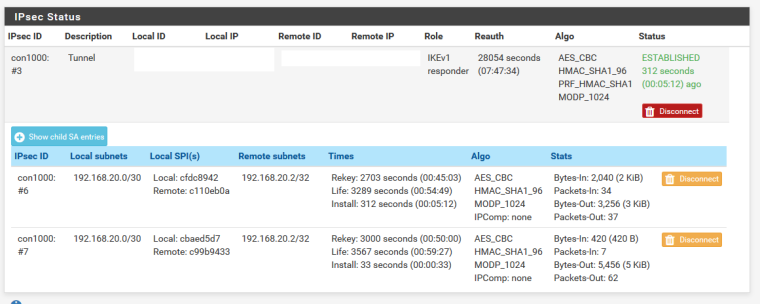




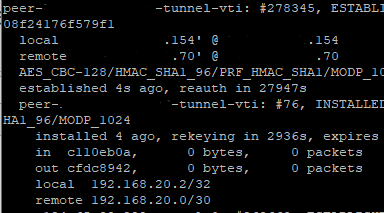
I have tried a variety of IP addresses on the local and remote in the VTI config, including the one in the online example.
-
That's all rather hard to read/parse jumbled up like that with so much blocked out and cut down, but there is still a bit of info missing.
I still need to see:
- The P2 settings (from the edit page, not the summary/list)
- The interface config on Interfaces > OPT1
- The output of
ifconfig ipsec1000 - The routing table entries for the
ipsec1000interface under Diagnostics > Routes
On all of mine no matter what I set in the P2 settings for the mask on the local network interface it makes /32 security associations in both directions. I have one pair set for /30 and another set for /24 and both work and show /32 for both ends in the SA list.
I don't have a USG to test against so there may be some quirk there.
Also, if you are going to mask/hide info in screenshots it's much better to use a contrasting color so it's obvious where the image has been altered. Use black for a white background, white for a dark background, etc. If it's masked out with the same color as the background it's difficult to discern what is hidden vs what might be incorrect/broken.
-
I've had this problem while trying to set up a VTI tunnel to an EdgeRouter Lite (similar to the USG in hardware, and I'd bet a little bit in software too). I changed the remote network from a single address to a /30 like my local network, and traffic started passing through once the new P2 SA was up.
But since the webConfigurator won't allow me to put in a network for the remote end, I wonder if this is the "correct" way to do things...
-
Hello, I'm trying to do the same as Zhongfu, but without success.
@zhongfu what did you do? Where did you change the remote address to a /30, in the pfsense or in the Edgerouter?
Thanks
-
@abounde on pfSense.
You could probably just enable the network type field in the phase2 configuration page (with "Inspect Element"?) then configure accordingly, or you could try this in the pfSense shell (assuming you've only got one phase2 config -- if you've got more, just change the [0]s to the appropriate value)
parse_config(true); $config['ipsec']['phase2'][0]['remoteid']['type'] = "network"; $config['ipsec']['phase2'][0]['remoteid']['netbits'] = 30; write_config(); -
If that worked I can change the GUI to not lock down the remote.
I originally locked it down because of how the man page for
if_ipsec(4)described configuring the interface, it only had a mask on the local component not the remote. If the local is set to /30 it should have the right mask for the interface as a whole. Is that not happening for you? -
@jimp I think it might be because strongswan doesn't know where to route the packets (?) -- just changing the strongswan configuration to
remote_ip/30for the remote allows traffic to go through -
@zhongfu thanks for your help, I did the changes (with "Inspect Element"?) and now my VPN Phase 2 setup is this:
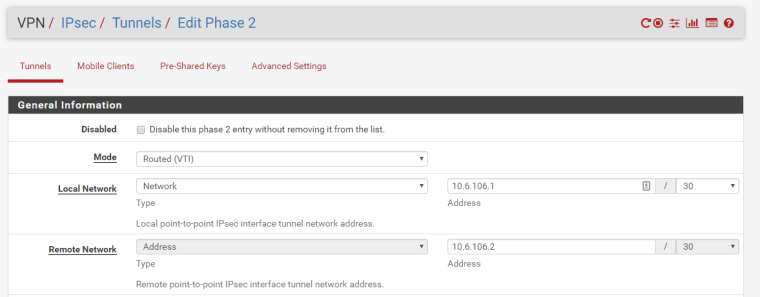
Now, I can ping from the LAN behing the EdgeRouter to the LAN Interface of the pfSense, but I can't ping to a host inside the LAN behind the pfSense.
In the opposite by, from the LAN behind the pfSense to the LAN behind the EdgeRouter I can't ping anything. But again, I can ping the LAN Interface of the EdgeRouter.
The firewall rules in both LAN interfaces are complete open.
My route table in the pfSense is this:

And in my EdgeRouter is this:

Could you check in your network/lab if you can ping from host to host, passing by the VPN tunnel.?
Thanks
-
I pushed a change to allow the remote type to be changed to Network. It defaults to address, but once set to Network it will retain that value.
-
@zhongfu could you paste here the EdgeRouter configuration?
I think my issue now is on the EdgeRouter side.
Thanks
-
@abounde don't think I can help you there -- I'm using BGP for my setup, and the ERL on the other end isn't mine.
maybe you'd want your gateway to be the VTI IP of the other end though? (e.g. 10.6.106.2 instead of ipsec1000 for the pfSense site, etc)
-
@jimp It looks like the VTI interface won't come up now, because if_ipsec(4) won't take a subnet mask for the remote component. However, strongswan doesn't seem to route packets between local and remote if the mask for
rightsubnetisn't the same as that forleftsubnetPerhaps it might be a good idea to strip the subnet mask from the remote before running
ifconfig ipsecX local_ip/30 remote_ip, or something similar like only accepting an address for the remote but adding the subnet mask fromlocal_iptoremote_ipin the strongswan config? -
I reverted the commit I made to allow changed on that field for now, since it was broken.
There seems to be two possible paths here:
- Still allow the field to be changed but (a) add input validation to prevent different masks and (b) ignore the mask bits when running ifconfig -- this could be confusing to the user though
- Prevent the field from being changed and inject the local mask bits into
rightsubnetin the strongSwan config.
Option #2 is much easier, but I am left to wonder how well that will interact with third party implementations that work now when the remote is an address. It may be fine, but needs testing.
If you want to try that, use the system patches package to revert da54e84ae79328a87b4a319239bb1b14d7ed2ce6 and then add the attached patch as another entry.
0_1536597185830_vti_force_rightsubnet_bits.diff -
@jimp said in IPSEC VTI Tunnels:
Option #2 is much easier, but I am left to wonder how well that will interact with third party implementations that work now when the remote is an address. It may be fine, but needs testing.
Hello @jimp, just to inform here is another user wating for a fix.
SonicWall needs a network as local network. For this i am getting this error:
IKEv2 Responder: Peer's destination network does not match VPN Policy's [Local Network] VPN Policy: XXXNAMEOFVPNXXX; Proposed network: 172.27.3.1-172.27.3.1It would be fine, if we could select a network as remote network on pfSense. Thanks a lot!
-
Palo Alto seems unhappy as well. I have a new patch to test but it does need testing. It comes up and works for me but I don't have access to any of these other devices (ubnt, sonicwall, PA, etc). Also need to be sure it doesn't interfere with other non-IPsec traffic and other non-VTI IPsec tunnels.
From my other post:
Try the attached patch and see if it helps. I could not get the VTI to come up and pass traffic with only
0.0.0.0/0in therightsubnetandleftsubnet, but it did seem to connect and work with the attached patch that has both the VTI endpoints and all zeroes. I haven't testing to see if it interferes with anything else yet, though, just VTI itself (BGP connects and exchanges routes, traffic passes)0_1538745996158_ipsec-vti-0.0.0.0.diff
Use the System Patches package to apply the diff, or make the changes by hand. After applying the patch, stop IPsec, then edit/save/apply the IPsec VTI P1 or P2 and it should restart with the new policy in place.
-
Hi Jim,
Long time pfSense user here.
Thought I would sign up to the forum to contribute to this. I have just installed patch 0_1538745996158_ipsec-vti-0.0.0.0.diff and setup a VTI between the pfSense and an EdgeRouter 4 (running the latest firmware) and I can report that the VPN is now working correctly. I'll let you know if I come across any subsequent strange behaviors, but everything is looking good so far.
-
@jimp I've encountered a similar issue (I could ping the tunnel IP addresses but nothing else) by doing a pfsense-debian buster ipsec connection. I can prepare a testcase on a vultr VM pair if required and ship you the credentials.
EDIT: I still see these in the log file(s) when I go to status-ipsec:
Oct 8 13:04:37 192.168.100.1 charon: 04[KNL] <con3000|3> querying policy 0.0.0.0/0|/0 === 0.0.0.0/0|/0 in failed, not found
Oct 8 13:04:37 192.168.100.1 charon: 04[KNL] <con3000|3> querying policy 0.0.0.0/0|/0 === 0.0.0.0/0|/0 out failed, not found
Oct 8 13:04:37 192.168.100.1 charon: 04[KNL] <con2000|2> querying policy 0.0.0.0/0|/0 === 0.0.0.0/0|/0 in failed, not found
Oct 8 13:04:37 192.168.100.1 charon: 04[KNL] <con2000|2> querying policy 0.0.0.0/0|/0 === 0.0.0.0/0|/0 out failed, not found
Oct 8 13:04:37 192.168.100.1 charon: 04[KNL] <con1000|1> querying policy 0.0.0.0/0|/0 === 0.0.0.0/0|/0 in failed, not found
Oct 8 13:04:37 192.168.100.1 charon: 04[KNL] <con1000|1> querying policy 0.0.0.0/0|/0 === 0.0.0.0/0|/0 out failed, not foundBut the tunnels are up and passing traffic.
-
@fsamareanu said in IPSEC VTI Tunnels:
@jimp I've encountered a similar issue (I could ping the tunnel IP addresses but nothing else) by doing a pfsense-debian buster ipsec connection. I can prepare a testcase on a vultr VM pair if required and ship you the credentials.
But the tunnels are up and passing traffic.
Is this with the new patch applied? If not, apply that patch.
EDIT: I still see these in the log file(s) when I go to status-ipsec:
Oct 8 13:04:37 192.168.100.1 charon: 04[KNL] <con3000|3> querying policy 0.0.0.0/0|/0 === 0.0.0.0/0|/0 in failed, not found
I'm not terribly surprised there, since VTI doesn't actually install the policy in the kernel since it isn't needed. That may be prohibitively difficult to suppress that warning but if I do end up committing this patch we can look into it after.
-
@jimp the warning is with the patch applied. The error was there before as well, just showing the /30 subnet and the corresponding remote tunnel ip.
I have not tested the pfsense-Linux ipsec tunnel after the pfsense patch. Will get to it tomorrow and update here.
-
@turbulence said in IPSEC VTI Tunnels:
Hi Jim,
Long time pfSense user here.
Thought I would sign up to the forum to contribute to this. I have just installed patch 0_1538745996158_ipsec-vti-0.0.0.0.diff and setup a VTI between the pfSense and an EdgeRouter 4 (running the latest firmware) and I can report that the VPN is now working correctly. I'll let you know if I come across any subsequent strange behaviors, but everything is looking good so far.
Mind sharing your configuration?
I am trying to get IPSec VTI running between PfSense and EdgeRouter X but i'm not able to get it working. (I already applied latest patch)
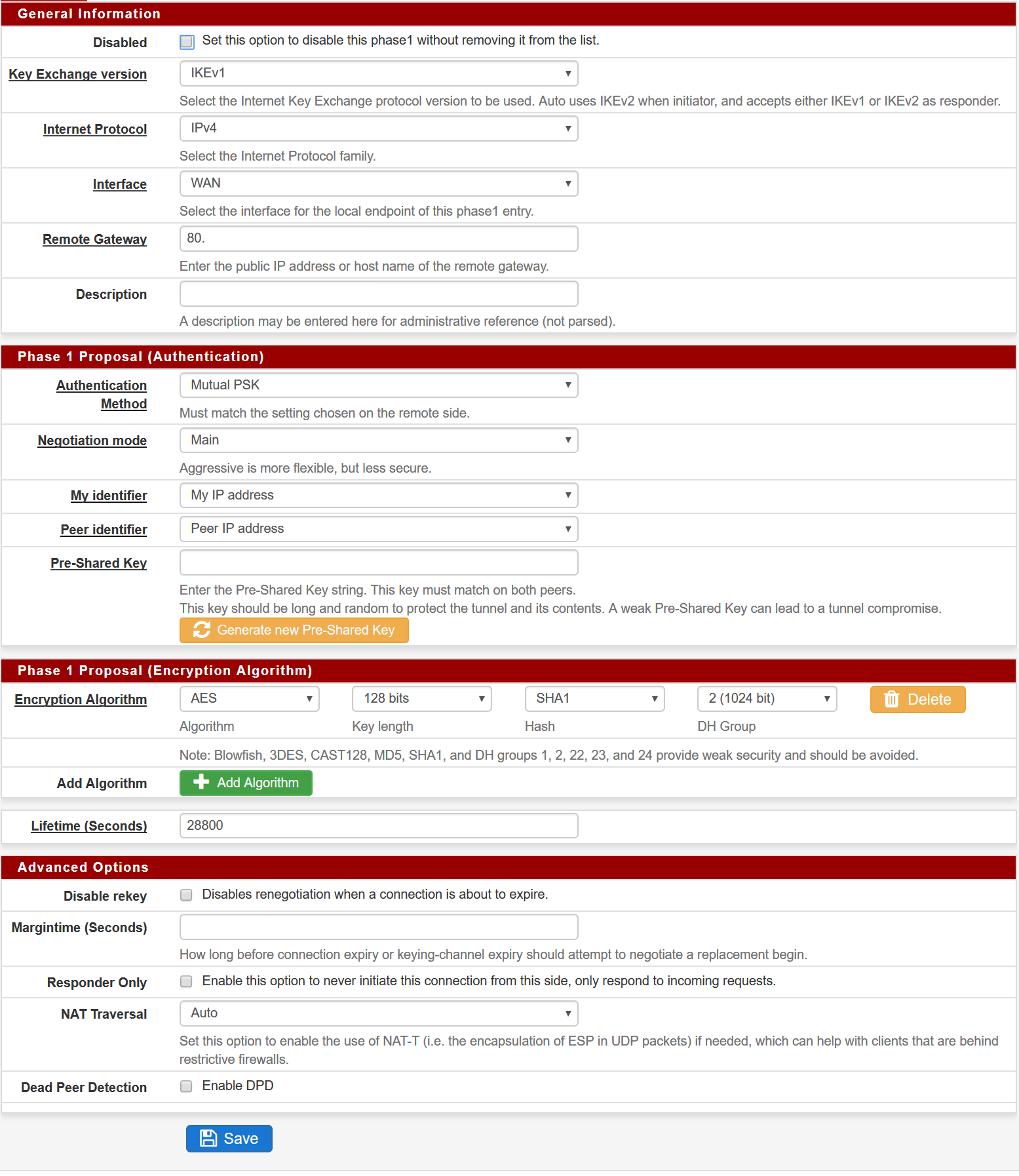
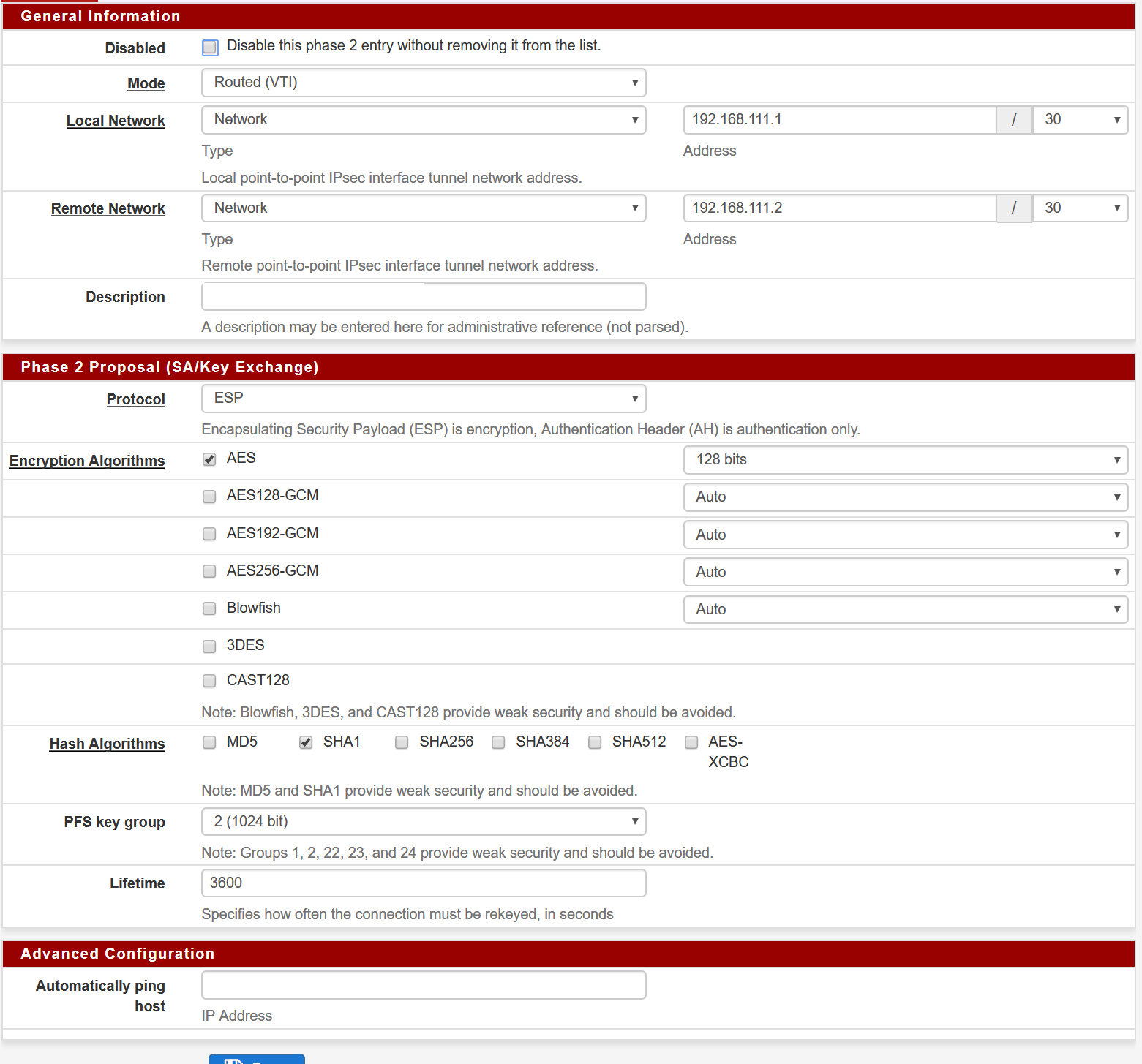
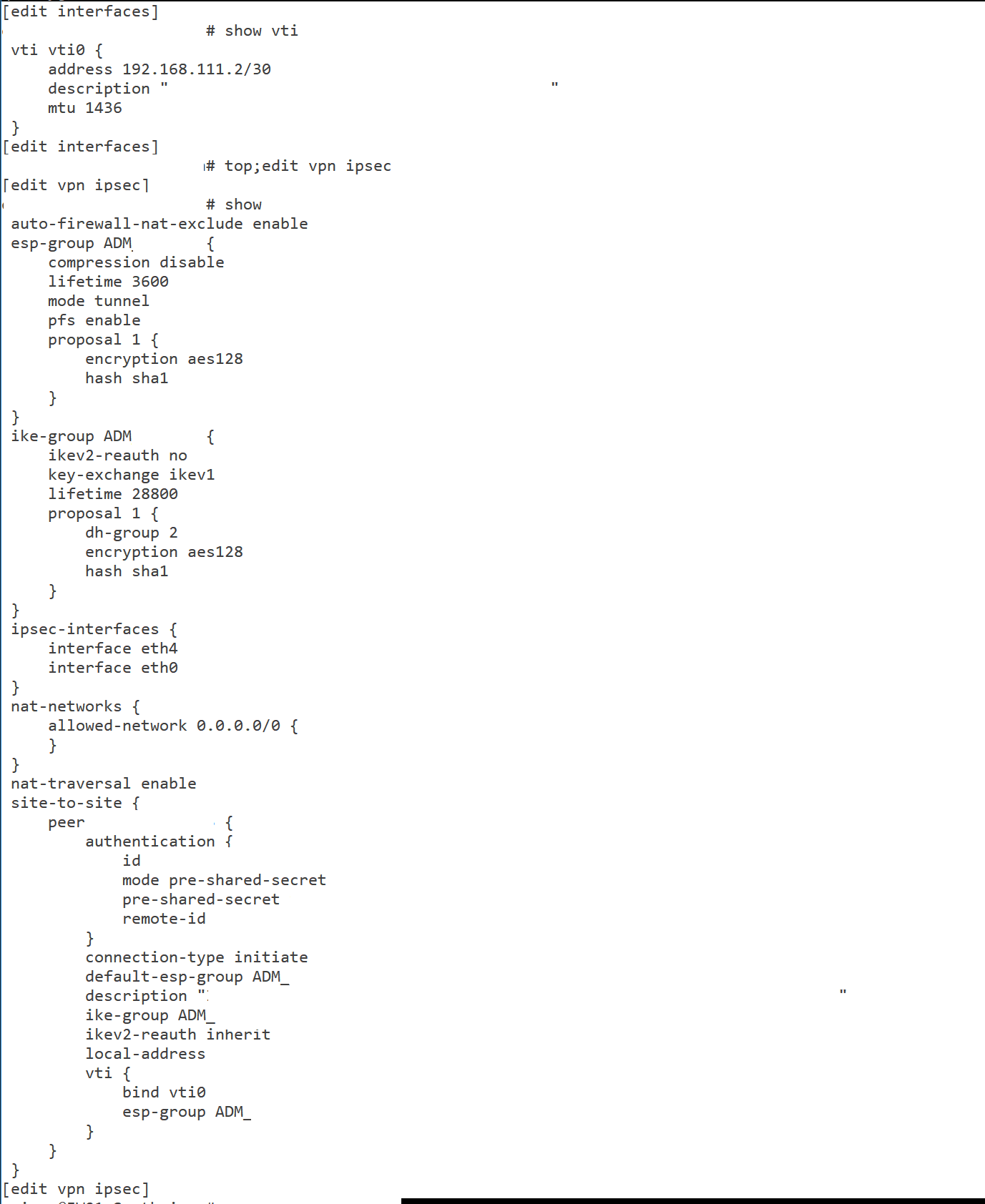
Logging:
Oct 12 09:11:40 charon 12[KNL] creating acquire job for policy X.X.X.X/32|/0 === X.X.X.X/32|/0 with reqid {0} Oct 12 09:11:40 charon 12[KNL] received an SADB_ACQUIRE with policy id 8936 but no matching policy found Oct 12 09:11:38 charon 06[CFG] vici client 148 disconnected Oct 12 09:11:38 charon 16[CFG] vici client 148 requests: list-sas Oct 12 09:11:38 charon 16[CFG] vici client 148 registered for: list-sa Oct 12 09:11:38 charon 08[CFG] vici client 148 connected